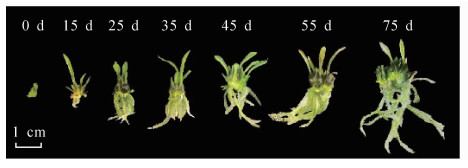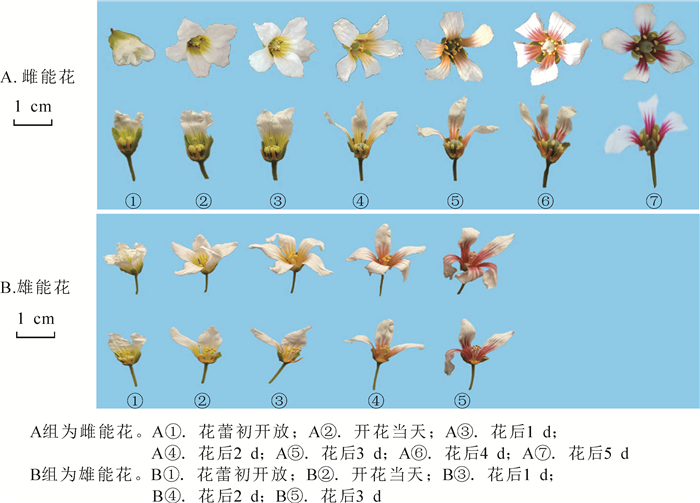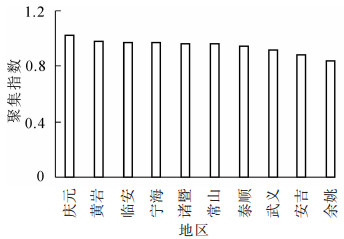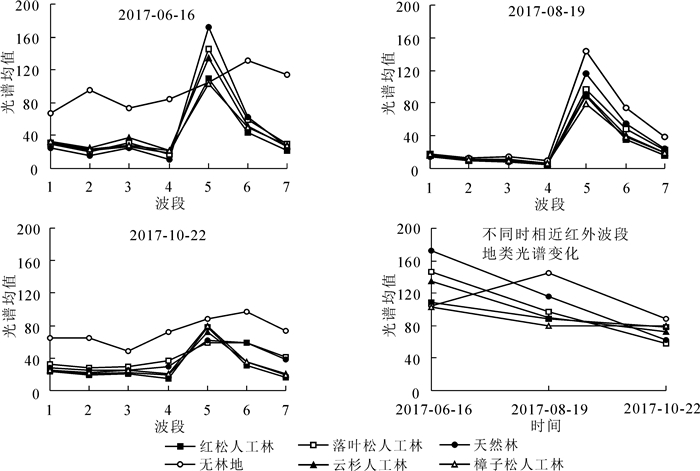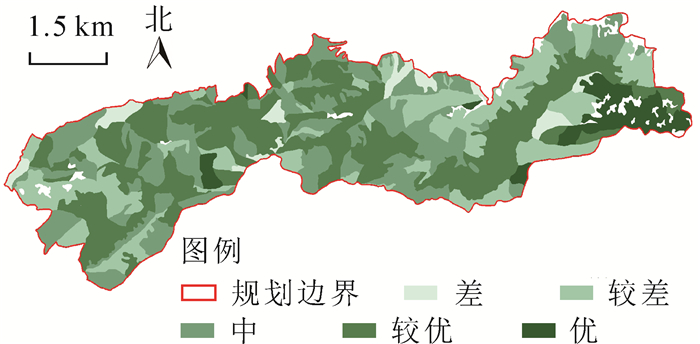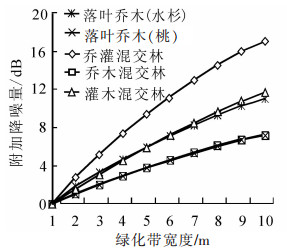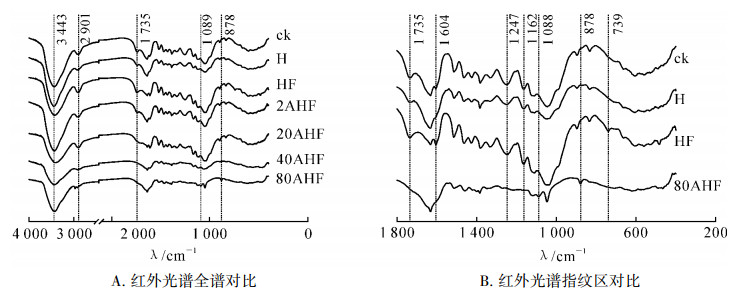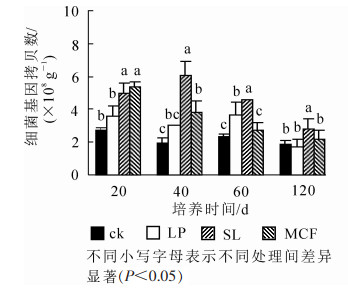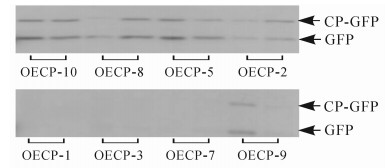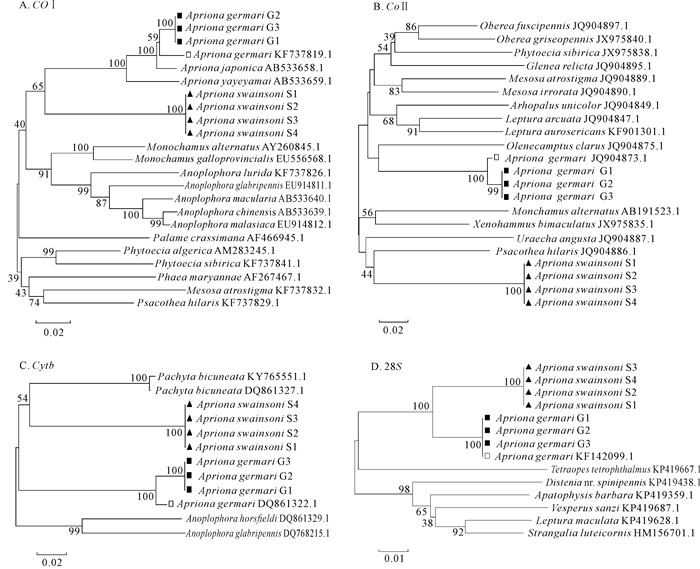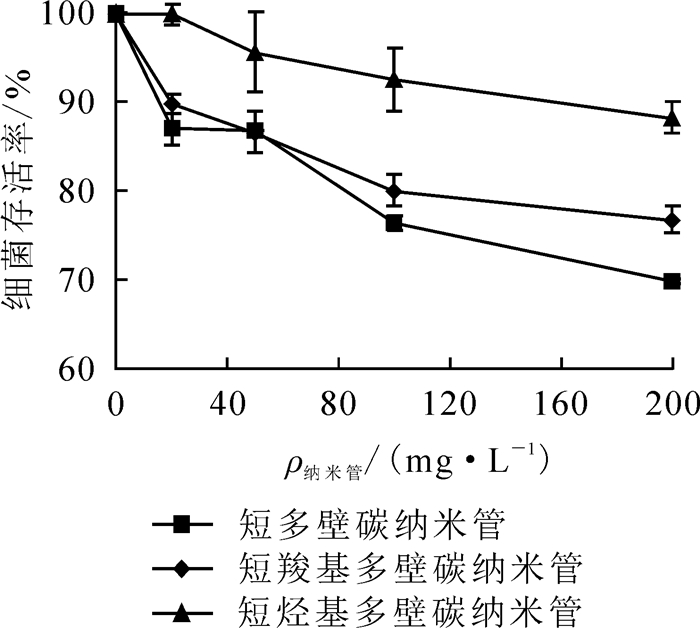2020 Vol. 37, No. 2
column
2020, 37(2): 195-200.
doi: 10.11833/j.issn.2095-0756.2020.02.001
Abstract:
Objective Sweet osmanthus (Osmanthus fragrans) is widely used in gardening as a fragrant plant. Its flower bud differentiation is significantly affected by ambient temperature. This research aims to find out the working mechanism of ambient temperature on the flower bud differentiation to help regulate flowering period of sweet osmanthus. Method Gene FCA (FLOWERING LOCUS CA) was studied using O. fragrans 'Yanhonggui' as the material, the process of flower bud differentiation was observed by paraffin section, and OfFCA was cloned and expression analysis was made by PCR and real-time PCR. Result The sequence length of OfFCA cDNA obtained by cloning was 1 319 bp, the Open Reading Frame(ORF) length was 864 bp, and 287 amino acids were encoded. Amino acid sequence alignment and evolutionary analysis showed that OfFCA was similar in FCA to Olea europaea, Oleaceae and Sesamum indicum, Pedaliaceae, with a homology of over 68%. The real time PCR demonstrated that the expression of OfFCA gene was higher at the low temperature (19℃) treatment than control temperature (25℃) in both leaves and flower buds at different flower bud differentiation stages. Conclusion Our work lay a foundation for the studying of regulating flowering time of O. fragrans by ambient temperature.
2020, 37(2): 201-208.
doi: 10.11833/j.issn.2095-0756.2020.02.002
Abstract:
Objective To promote the breeding speed of Lilium spp. bulbs, a study is conducted of the metabolism of starch, a major component of lily bulbs. Method Taking the bulbs in vitro of oriental hybrids Lilium 'Sorbonne', the most popular variety as the research subject, observations are made of the morphological changes and starch accumulation during different development stages. Thereafter, the granule bound starch synthase gene LohGBSSI was cloned with RACE employed, and the gene expression profiles of different tissues and development stages were analyzed. Result (1) During the formation and development process of lily bulblets cultured in vitro, in terms of the morphological traits and source-sink transition, there are mainly three stages namely the initial swelling stage, the rapid swelling stage and later swelling stage. (2) The total length of LohGBSSI (GenBank accession number:MF101407.1) is 1 913 bp, and the open reading frame is 1 665 bp, encoding 554 amino acids, which was highly homologous to GBSSI of Lilium davidii var. unicolor (92%), suggesting that this gene might belong with the GBSSI gene family. (3) The expression of LohGBSSI gene in bulbs and leaves was significantly higher than that in stem segments and roots, indicating that the most important site for amylose synthesis was the main source-sink organs. Furthermore, the LohGBSSI expression was highest at 15 d in bulblet, suggesting that rapid starch synthesis is a necessity for the early bulblet morphogenesis. Conclusion This study has laid a foundation for further functional analysis of GBSS in bulb development and also provided a basis for future lily starch relevant gene modification.
2020, 37(2): 209-219.
doi: 10.11833/j.issn.2095-0756.2020.02.003
Abstract:
Objective The present study attempts to provide reference for scientific allocation of pollination trees and superior clone popularization of Xanthoceras sorbifolium by investigating the best pollination combinations of the excellent clones to increase fruit setting rate and seed yield. Method Five superior clones were chosen to observe florescence phenology, stigma receptivity, and pollen viability. Control pollination was carried out to analyze the fertilization rate, fruit setting rate, and characters of each pollination combination related to seed yield. Result (1) The florescence stage of the 5 clones was from April 27 to May 14. (2)The stigma receptivity of female flowers was higher on the day of blooming and one day after that. (3)The pollen viability of male flowers was higher on the days of initial blooming and the complete blooming. (4)Considering fertilization rate, final fruit setting rate, seed yield, and fruit and seed characters of all pollination combinations, the optimal pollination combinations for No.10 were 10×16 and 10×119, and the recommended combinations for No.14, No.15, and No.16 were 14×15, 15×16, and 16×15 respectively. No.10, No.14, No.15 and No.16 were not suitable for pollination clone of No.119. Conclusion The fruit setting rate and seed yield of X. sorbifolium can be improved by scientific pollination combination.
2020, 37(2): 220-227.
doi: 10.11833/j.issn.2095-0756.2020.02.004
Abstract:
Objective To reveal the spatial distribution pattern in different life cycle stages, and to provide a scientific basis for protection of Sinojackia rehderiana, which was naturally distributed in Yongxiu County, Jiangxi Province. Method To probe causes of the spatial distribution pattern formation, the adjacent lattice sampling method, the spatial sequence method instead of time sequence, and the O-ring Completely Random Zero Model method were used to analyze the spatial distribution pattern and spatial correlation of individuals in different life cycle stages of a natural population of S. rehderiana. Result The DBH class structure and height class structure of S. rehderiana were complete, and the number of seedlings and saplings occupied an absolute advantage for the entire population. Population renewal, which belonged to the growth population, was in a favorable condition. In the process of development from seedling to adult tree, the population of S. rehderiana had an aggregated distribution on a small scale, and had a random to uniform distribution on a large scale. As the age class increased, the aggregated distribution receded. On a small scale, at different life cycle stages of S. rehderiana, there was a significantly positive correlation or no correlation(P=0.05); however, on a large scale there was a negative association or no correlation. The spatial association between seedlings and middle-aged trees, saplings and middle-aged trees, and saplings and adult trees was significantly negative (P=0.05). Conclusion In a natural state, the distribution pattern of S. rehderiana was influenced by its own biological factors, intraspecific competition, and interspecific competition; seedling and sapling growth was limited but plentiful; and the population was not currently in a stable state.
2020, 37(2): 228-234.
doi: 10.11833/j.issn.2095-0756.2020.02.005
Abstract:
Objective Spatial structure characteristics and differences of moso bamboo (Phyllostachys edulis) forests in different regions of Zhejiang Province were studied. Method The close-to-nature moso bamboo forests in different regions of Zhejiang Province were taken as the research objects, 54 sample plots were set up, and spatial structure indices (aggregation index, competition index and age mingling) were used to analyze spatial structure characteristics and differences of moso bamboo forests in different regions of Zhejiang Province. Result The mean competition index of moso bamboo forest in different regions of Zhejiang Province is 2.88-8.81, among which Yuyao is the largest and Qingyuan is the smallest. The mean age mingling is 0.30-0.84, the largest in Huangyan and the smallest in Wuyi. The mean aggregation index is 0.73-1.24, the largest in Ninghai area and the smallest in Yuyao area. There was no significant difference in age mingling and aggregation index among different regions in Zhejiang Province, whereas there was significant difference in competition index among different regions in Zhejiang Province(P < 0.05). Conclusion The spatial distribution pattern of moso bamboo forests in Zhejiang Province was mainly aggregated distribution. The spatial structure index has a certain regional variation trend, and the competition index decreases gradually from north to south.
2020, 37(2): 235-242.
doi: 10.11833/j.issn.2095-0756.2020.02.006
Abstract:
Objective The study analyzed seasonal characteristics of Larix gmelini plantation based on multi-temporal remote sensing images, and extracted the spatial distribution of L. gmelini plantation in a forest farm located in northeast China by using various classification methods, so as to obtain the means and methods suitable for the extraction of L. gmelini plantation. Method Multi-temporal Landsat 8 ancillary forest resource investigation and ground plot were applied in classification process by using the maximum likelihood method, support vector machine method, spectral angle method and k nearest neighbor method, on the basis of analyzing the seasonal and phonological characteristics of L. gmelini plantations to extract information of L. gmelini plantation in the study area, and meanwhile the accuracy was verified. Result The L. gmelini plantation had obvious vegetation spectral features and seasonal characteristics, and the spectral differences among tree species were most obvious in the near-infrared band. The autumn image was good for information extraction of L. gmelini plantation, and the extraction precision using multi-phase data was significantly better than that of single-phase data. The classification accuracy of L. gmelini plantation could reach more than 86% with multi-temporal Landsat 8 image, among which the spectral angle method was the best, with an accuracy of 88.346 3%. Conclusion It is feasible and applicable to study L. gmelini plantation information extraction by using multi-temporal feature remote sensing image. The results have reference value for large-area extraction of spatial distribution of L. gmelini plantation.
2020, 37(2): 243-250.
doi: 10.11833/j.issn.2095-0756.2020.02.007
Abstract:
Objective The rational evaluation of forest ecological function can provide basis for formulating the corresponding measures to improve the ecological function of forests, Method Taking Guanyindong Nature Reserve in Nanxiong, Guangdong Province as an example, 19 indicators related to forest ecological function were selected and a forest ecological function evaluation system was established by projection pursuit classification. Result (1) The relatively excellent grade forest in the reserve occupied an obvious advantage, but the overall rating of the reserve was medium. (2) The forest structure in the reserve is generally good, but there are too many bamboo forests and young trees, which caused weak forest accumulation capacity and low degree of naturalness. (3) Canopy density, litter thickness, number of trees per hectare, average height and total coverage belonging to 19 indicators in the evaluation process are extremely important. Slope position, naturalness, elevation, age group, soil layer thickness, forest community structure, average DBH, and slope direction are generally important. And hectare biomass, hectare accumulation, tree species structure, health, slope, and soil type are not so important. Conclusion Suggestions by the preceding evaluation grade are as follows:(1) Monitoring and protecting should be implemented in the excellent and relatively excellent grade forests. Finding the symptomatic reasons, monitoring and protecting the medium grade forests emphatically. Poor and relatively poor grade forests should be closed hillsides to facilitate afforestation. (2) The reserve should control the growth and expansion of bamboo forests. (3) The functional zoning of protected areas can be adjusted appropriately according to the evaluation results.
2020, 37(2): 251-258.
doi: 10.11833/j.issn.2095-0756.2020.02.008
Abstract:
Objective Under the rapid development of urbanization, the impact of pollution caused by urban traffic noise on the living quality of urban residents has been increasingly recognized. Among many solutions to noise reduction, the green belts on the city roads enjoy the unique advantage in the reduction of traffic noise. The order is to provide references for the selection of measurement index of the noise reduction ability of the urban green belt, and give suggestions on how to achieve the optimal noise reduction effect of the urban green belt construction. Method This research studies the road forest belts on the major traffic roads of 11 areas (counties, cities and districts) in the Yangtze River Delta and uses the comprehensive comparative analysis of the ratio of different forest belt types, living vegetation volume and the under branch height to conduct a preliminary evaluation on the noise reduction of green belts. Result The noise reduction of green belts on the major traffic roads in Xuanwu District of Nanjing and Runzhou District of Zhenjiang are most effective among the 11 areas (counties, cities and districts), while those in Lianyun District of Lianyungang and Qingyuan Town of Lishui are least effective. Rationally mixed forest of arbor and shrub is better for the noise reduction. The results of the simulation model indicate a positive relationship between additional noise reduction of 11 areas (counties, cities and districts) and the living vegetation volume obtained from statistics. Conclusion From the comprehensive analysis of the combination of the living vegetation volume and the under branch height, it could be concluded that the effect of noise reduction within the range of 2 m of the under branch height is better.
2020, 37(2): 259-265.
doi: 10.11833/j.issn.2095-0756.2020.02.009
Abstract:
Objective This study aims to explore the soil genesis of soil profiles from basalt in eastern Zhejiang Province, and to provide a comprehensive understanding of soil genesis in subtropical regions for efficient use of land resources. Method Four soil profiles developed from basalt in Xinchang-Shengzhou Basin were selected. The major element composition, chemical weathering indexes[chemical index of alteration(ICIA), chemical index of weathering(ICIW)] and element migration of soil were analyzed. Result (1) The main components in different profiles were SiO2, Al2O3, and Fe2O3, whose total content reached over 79%. (2) ICIA value was 42.81%-87.37%, and ICIW value was 45.04%-91.43%, both indicating moderate strength of chemical weathering. (3) The major element migration of most soil samples was negative. Ca, K, Mg and Na were leached out of the soil in large quantities and the mobility in the profile was significantly negative (up to a minimum value of -99%). Al, Fe and Ti elements were relatively enriched in the deposition layer (B) of some profiles, and the migration rate was over zero. The major element migration gradually decreased with soil depth. Conclusion (1) The chemical composition of the soil samples in different profiles was consistent. (2)The soil in the study area experienced a relatively strong chemical weathering process under the humid and hot environment. (3) The soil genesis conformed to the desilicification and allitization basic soil formation process in subtropical regions. The law of major element migration changing with soil depth in each profile suggested the gradual bottom-up weathering characteristics of the soil developed from the bedrock.
2020, 37(2): 335-342.
doi: 10.11833/j.issn.2095-0756.2020.02.019
Abstract:
Objective To obtain regenerated cellulolytic enzyme lignin (RCEL), ball-milled bamboo (Phyllostachys edulis) was dissolved, regenerated, and subjected to cellulose enzymatic hydrolysis in a lithium chloride/dimethyl sulfoxide (LiCl/DMSO) solvent system before the enzymatic residue is extracted and purified in the solvent. Method First, the chemical composition of lignin was determined with the standard method. Then, the structures and contents of the isolated lignin were analyzed by means of Fourier transform infrared(FT-IR)spectroscopy, alkaline nitrobenzene oxidation and proton nuclear magnetic resonance(1H NMR). Afterwards, gel permeation chromatography(GPC) was conducted to analyze the molecular weight and polydispersity of lignin while X-ray diffraction was used to evaluate the effect of dissolution and regeneration of bamboo on the cellulose crystallinity. Result (1) In terms of the chemical composition, the yield and purity of RCEL were higher. (2) The isolated bamboo RCEL lignin was GSH lignin whose condensation degree was slightly higher than that of cellulolytic enzyme lignin(CEL), the content of Syringyl structural unit was higher, almost reaching 50% (w/w), and the proportion of structural unit did not change during the separation process. (3) In terms of molecular weight and its distribution, both of the average molecular weight and weight average molecular weight of bamboo RCEL lignin were high, and there was no occurrence of lignin degradation during the separation process. (4) The crystallinity of cellulose decreased after swelling treatment of LiCl/DMSO solvent system with X-ray diffraction. (5) The thermogravimetric temperature of RCEL lignin was between 200℃ and 600℃ and different pyrolysis features are presented with different condensation degrees of lignin. Conclusion This separation method based on LiCl/DMSO solvent system had a good protective effect on the macromolecular structure of lignin while caused damage in carbohydrates structure. It could change the cellulose crystallization region and reduce the degree of crystallization, thus promoting the degradation of cellulose and improving the efficiency of enzyme hydrolysis, which were beneficial to the efficient separation of CEL. Compared with milled wood lignin (MWL) and CEL isolated with the traditional separation method, the RCEL lignin separated using the current separation method could better represent the protolignin of bamboo.
2020, 37(2): 343-349.
doi: 10.11833/j.issn.2095-0756.2020.02.020
Abstract:
Objective The research aim is to improve add value of bamboo leaves. Method Novel composites were prepared from ethanol treated bamboo leaves(Phyllostachys edulis) by both hot press molding and injection molding, using high density polyethylene (HDPE) as reinforcing agent and appropriate amount of additives. The structure and properties of the composite were characterized by fourier transform infrared spectroscopy (FTIR), X-ray diffraction (XRD), scanning electron microscopy (SEM) and thermogravimetric analysis (TGA), and the effects of different contents of bamboo leaves on the properties of composites by the two different molding processes were investigated. Result Thermal analysis results showed that the thermal stability of the composites prepared by the two different molding processes increased with the increase of the relative content of bamboo leaves. Mechanical property results indicated that the tensile modulus of composite prepared by injection molding also increased with the increase of the content of bamboo leaves, while the tensile strength decreased. When the content of bamboo leaves increased, the bending strength of the composite increased first and then decreased. The maximum bending strength of the composites obtained by hot press molding and injection molding reached 28.72 and 30.20 MPa when the bamboo leaf content was 40%. The bending modulus of composites obtained by hot press molding and injection molding increased with the increase of the content of bamboo leaves, and the maximums reached 1 564.92 and 1 696.15 MPa, respectively. The impact strength gradually decreased with the increase of the bamboo leaf content. Conclusion In contrast, the hot pressed bamboo leaf/HDPE composite had more stable thermal properties, and could be a new environmentally friendly material.
2020, 37(2): 350-356.
doi: 10.11833/j.issn.2095-0756.2020.02.021
Abstract:
Objective The strong permeability and reactivity of gaseous fluorine supposedly helps form chemical bonds between fluorine and bamboo. This aim is to increase the leaching resistance of gaseous fluorine Method The four-year-old bamboo (Phyllostachys edulis) was heated in a tubular reactor at 150℃ and treated with 25% fluorine for 4 h. To improve the fluorination effect, bamboo was pretreated with sulfuric acid at different concentrations before the fluorine thermo treatment. Analysis included fourier transformed infrared spectra and X-ray photoelectron spectroscopy. Tests on mold resistance for fluorinated bamboo with mixed fungi of Trichoderma viride, Penicillium citrinum, and Aspergillus niger were conducted. Result The chemical analysis and testing of fluoride bamboo showed obvious changes in lignin. Fourier transformed infrared spectra demonstrated that the new peaks at 739 cm-1 were C-F (carbon-fluorine) monosubstituted bonds; whereas, concentrated sulfuric acid pretreated fluorinated bamboo showed double C-F peaks at 878 and 1 088 cm-1 caused by the polysubstitution of C-F bonds on the benzene ring of lignin. Binding energies of 687.8 eV (C-F) and 689.2 eV (C-F2) in X-ray photoelectron spectroscopy confirmed the presence of the C-F bond in fluorinated bamboo. The dimensional stability of treated bamboo was tested under three moistening-drying cycles and water soaking-drying cycles, respectively. The average anti-shrink efficiency (ASE) for three cycles of thermo fluorinated bamboo was 19.1% for moistening-drying and 7.5% for water soaking-drying. Sulfuric acid pretreatment further improved dimensional stability of thermo fluorinated bamboo where 20 g·kg-1 sulfuric acid pretreatment behaved the best with a corresponding ASE of 31.0% for moistening-drying and 15.8% for water soaking-drying. Tests on mold resistance for fluorinated bamboo with mixed fungi of T. viride, P. citrinum, and A. niger, showed no obvious anti-mold efficacy; whereas, for fluorinated bamboo pretreated with sulfuric acid there was slight improvement. Conclusion Thus, with gaseous-phase thermo fluorination, a new way of bamboo modification with strong permeability and high reactivity, dimensional stability and mold resistances of treated bamboo were better than the controls making them effective for inner modification of bamboo.
Effect of agricultural structural adjustment on the growth of agricultural total factor productivity
2020, 37(2): 357-365.
doi: 10.11833/j.issn.2095-0756.2020.02.022
Abstract:
[Objective] Under the common constraints of the law of diminishing marginal returns and the resource environment, relying on factor inputs to promote agricultural growth is not sustainable. Therefore, continuous improvement of agricultural total factor productivity (TFP) is particularly important for the sustainable growth of China's agriculture.[Method] Using the multiplicatively complete Hicks-Moorsteen TFP index, China's agricultural total factor productivity growth is completely decomposed into technological progress, technological efficiency changes, scale efficiency changes and mixed efficiency changes. The adjustment of agricultural structure affects the growth of agricultural TFP by changing mixed efficiency.[Result] From the time dimension, only the change of mixed efficiency between 1992-1997 contributed 0.5 percent to the growth of agricultural TFP, that is, the adjustment of agricultural structure during this period promoted the growth of agricultural TFP. From the regional perspective, only the mixed efficiency change in the eastern region contributed 0.4 percent to the growth of agricultural TFP in the eastern region, that is, the adjustment of agricultural structure in the eastern region promoted the growth of agricultural TFP in the eastern region. The growth of agricultural TFP in China mainly comes from technological progress. The effects of agricultural restructuring on the growth of agricultural TFP are comparatively different by time and space.[Conclusion] The agricultural structure should be adjusted according to market demand, resource endowment and comparative advantage, in order to improve the mixed efficiency and promote the growth of agricultural TFP.
[Objective] Under the common constraints of the law of diminishing marginal returns and the resource environment, relying on factor inputs to promote agricultural growth is not sustainable. Therefore, continuous improvement of agricultural total factor productivity (TFP) is particularly important for the sustainable growth of China's agriculture.[Method] Using the multiplicatively complete Hicks-Moorsteen TFP index, China's agricultural total factor productivity growth is completely decomposed into technological progress, technological efficiency changes, scale efficiency changes and mixed efficiency changes. The adjustment of agricultural structure affects the growth of agricultural TFP by changing mixed efficiency.[Result] From the time dimension, only the change of mixed efficiency between 1992-1997 contributed 0.5 percent to the growth of agricultural TFP, that is, the adjustment of agricultural structure during this period promoted the growth of agricultural TFP. From the regional perspective, only the mixed efficiency change in the eastern region contributed 0.4 percent to the growth of agricultural TFP in the eastern region, that is, the adjustment of agricultural structure in the eastern region promoted the growth of agricultural TFP in the eastern region. The growth of agricultural TFP in China mainly comes from technological progress. The effects of agricultural restructuring on the growth of agricultural TFP are comparatively different by time and space.[Conclusion] The agricultural structure should be adjusted according to market demand, resource endowment and comparative advantage, in order to improve the mixed efficiency and promote the growth of agricultural TFP.
2020, 37(2): 366-373.
doi: 10.11833/j.issn.2095-0756.2020.02.023
Abstract:
Objective To explore the differences of touristsundefined perception of the value in different forest cultures and the causes of the differences. Method Forest cultural value is an important part of forest ecosystem. On the basis of defining the connotation and extension of forest cultural value, eight categories of forest cultural values are determined, and a questionnaire is designed to study tourists' perception of the forest cultural values in Mount Tianmu. Result The results show that 71.2% of the tourists recognize the eight categories of forest cultural values in Mount Tianmu, among which the physical and mental health (95.5% with an average score of 1.62) and aesthetic (95.5% with an average score of 1.48) are the most recognized and score the highest. Leisure and recreation (85.6%, average score 1.39), education and scientific research (87.1%, average score 1.32), sense of locality (87.9%, average score 1.25), cultural heritage (83.0%, average score 1.17). Inspiration (75.8%, with an average score of 0.97), religion and spiritual service (71.2%, with an average score of 0.88) have the lowest number of people with the lowest score. The background of tourists also has a certain impact on their perception of forest cultural value. The tourists under 40 years old have a significantly lower perception of leisure and recreation value than other age groups, and the tourists between 40 and 60 years old have a higher perception of leisure and recreation, aesthetics and sense of place than other age groups. Tourists' perception of Mount Tianmu's aesthetic core sense of locality will first rise and then decline with the extension of their stay time, and the perception of visitors staying from one week to one month is the highest. Conclusion Therefore, in the construction process of Mount Tianmu spot, it is necessary to avoid excessive development of physical and mental health and aesthetic value, and strengthen the excavation of inspiration, religion and spiritual service value.
2020, 37(2): 374-381.
doi: 10.11833/j.issn.2095-0756.2020.02.024
Abstract:
Objective To explore the spatial layout features of forest towns in Zhejiang Province and conclude the human and natural factors that affect the spatial layout, this research is conducted of the geographic data of 73 forest town and 121 provincial or national forest parks in Zhejiang as well as the indicators of the natural and social conditions of their respective cities. Method With the nearest neighbor index, Gini coefficient, correlation analysis and kernel density method adopted, ArcGIS 10.2 and SPSS 19.0 software are employed to study the main spatial distribution features and influencing factors of these forest towns and forest parks. Result (1) The 73 forest towns in Zhejiang Province are concentrated. Specifically, forest towns are evenly distributed in the north of Zhejiang, eastern Zhejiang and southern Zhejiang, yet they are concentrated in the west of Zhejiang; (2) The distribution of forest towns in different cities is relatively balanced; (3)In terms of kernel density estimation values(from high to low), the towns can be divided into three main echelons, the ones in the western and northern parts of Huzhou, the ones in the northern and central part of Quzhou, and the ones in Lishui, Wenzhou and Taizhou, subject to factors such as resources endowment, policies, distribution of mountains, transportation and neighboring cities. Conclusion Concentrated in economically underdeveloped areas along foothills and valleys, forest towns are designed to facilitate the green and sustainable development of the local economy. The fast development of the highway network is conducive to the development of forest towns though the influence of the respective cities on the layout of forest towns is very limited. On the other hand, the high correlation between the location of the forest town and that of the spatial distribution of the forest park is indicative of the dependence of forest towns on the abundant forest resources around as the vital guarantee for development. Given the huge potential of developing forest towns in other parts of Zhejiang, on the basis of the above results, this research has put forward some feasible suggestions on rationalizing the spatial layout of forest towns.
2020, 37(2): 382-390.
doi: 10.11833/j.issn.2095-0756.2020.02.025
Abstract:
Seeds are the most fundamental means of agriculture production, and their vitality will directly affect the production and development of agriculture. The detection methods of seed vigor are mainly divided into two categories:non-destructive testing and lossy testing. With advantages of no damage to seed samples, high detection efficiency, online detection, good repeatability and less experimentation pollution, non-destructive seed vigor testing methods include near-infrared spectroscopy, hyperspectral detection, electronic nose detection, and machine vision detection. Based on the development status of non-destructive testing technology for seed vigor at home and abroad, this paper comprehensively reviews methods, techniques and detection results of non-destructive testing of seed vigor, and summarizes the characteristics, application status, research progress, advantages and disadvantages in practical application, summarizes the current methods of non-destructive testing of seed vigor at home and abroad, and forecasts the development trend.
Seeds are the most fundamental means of agriculture production, and their vitality will directly affect the production and development of agriculture. The detection methods of seed vigor are mainly divided into two categories:non-destructive testing and lossy testing. With advantages of no damage to seed samples, high detection efficiency, online detection, good repeatability and less experimentation pollution, non-destructive seed vigor testing methods include near-infrared spectroscopy, hyperspectral detection, electronic nose detection, and machine vision detection. Based on the development status of non-destructive testing technology for seed vigor at home and abroad, this paper comprehensively reviews methods, techniques and detection results of non-destructive testing of seed vigor, and summarizes the characteristics, application status, research progress, advantages and disadvantages in practical application, summarizes the current methods of non-destructive testing of seed vigor at home and abroad, and forecasts the development trend.
2020, 37(2): 391-396.
doi: 10.11833/j.issn.2095-0756.2020.02.026
Abstract:
Objective To realize the large-scale production of Nandina domestica 'Firepower', this research is focused on the optimization of the regeneration system of the stem segments of 'Firepower' in vitro. Method With stem segments of 'Firepower' as the explant, a study is conducted of the key factors such as the basic medium, 6-BA and NAA concentration, sugar concentration and pH that affect the adventitious bud induction, proliferation and rooting. Result (1) The ideal medium for adventitious bud induction was WPM+0.50 mg·L-1 6-BA+0.10 mg·L-1 NAA, with an induction rate of adventitious bud of 93.8%, and a robust growth rate; (2) The medium for adventitious bud multiplication was WPM+0.75 mg·L-1 6-BA+0.10 mg·L-1 NAA, with a proliferation cofficient of 3.3 and favorable growth of the new bud; (3) The rooting medium was 1/2 WPM+0.50 mg·L-1 NAA + white sugar 30.0 g·L-1(pH 6.0), with a rooting rate of 95.0%. Conclusion The regeneration system of the stem segments of 'Firepower' in vitrothat has been optimized in the current study will provide reliable technical support for large-scale production of 'Firepower'.
2020, 37(2): 266-272.
doi: 10.11833/j.issn.2095-0756.2020.02.010
Abstract:
Objective To explore the effects of planting densities on soil nutrients of different soil layers for a Populus tomentosa plantation. Method 10-year-old S86 clones were used to study the soil nutrient characteristics with three planting densities (T1:2 m×2 m; T2:4 m×3 m; and T3:4 m×5 m) for six soil layers (0-5, 5-10, 10-20, 20-40, 40-60, and 60-100 cm). In mid-October 2016, soil samples were collected, and the contents of carbon (C), available nitrogen (N), available phosphorus (P), and available potassium (K) were determined and in total there were 3 treatments with 3 replicates, then one-way ANOVA and Duncan's multiple comparison tests were used to determine significant differences. Result The proportions of nutrients in the 0-20 cm layer compared to the 0-100 cm layer were:C(69%), N(79%), P(71%), and K (74%). The content of soil nutrients varied for the three planting densities. The highest C content found in T2 (15.44 g·kg-1 in the 0-5 cm layer) was significantly higher (P < 0.05) than T1; the C content in the 5-20 cm layer was significantly different (P < 0.05) than other densities in the order of T3 > T2 > T1; and in the 40-100 cm layer, the T1 content was significantly lower (P < 0.05) than other densities. The N content in T2 was 14.5-142.7 mg·kg-1. The P content was 1.3-12.4 mg·kg-1 with the content of T2 being significantly higher (P < 0.05) than other layers from 5-40 cm; however, in the 40-100 cm layers the content was T3 > T2 > T1. Planting density, though, had no significant effect on K content (P>0.05). Conclusion Nutrient content varied according to planting density and soil layers with the soil nutrient content of 10-year-old P. tomentosa clone S86 gathered in the 0-20 cm layer for the 2 m×2 m density having a lower nutrient content than the 4 m×3 m and 4 m×5 m densities.
2020, 37(2): 273-283.
doi: 10.11833/j.issn.2095-0756.2020.02.011
Abstract:
Objective This study attempts to determine the efficacy of applying limestone powder and microbial fertilizer to enhance soil chemical properties and microbial communities in the diseased Carya cathayensis woodland. Method Soil from dead C. cathayensis woodland was collected for culture experiment. The four treatments tested included a control (ck) with no amendment and three amendment treatments:limestone powder (LP), Bacillus fluid (SL), microbial compound fertilizer (MCF). Soil samples were collected at day 20, 40, 60 and 120, and analyzed for chemical properties. Additionally, the abundances and community structures of soil bacteria and fungi were examined using quantitative PCR and PCR-DGGE, respectively. Result The LP greatly improved the soil pH, but had no significant effect on other soil chemical properties or microbial community structure or abundances. Both SL and MCF treatments significantly(P < 0.05)increased soil organic carbon content as well as alkali-hydrolysable nitrogen and available phosphorus and potassium. The SL treatment increased soil pH, and in the short term(60 d)increased the abundance of bacteria and fungi, but decreased microbial diversity. In contrast, MCF treatment reduced the soil pH, significantly (P < 0.05) increased the abundance of soil fungi, and in the short term (40 d) increased bacterial abundances, but the bacterial community diversity reduced significantly (P < 0.05) and the diversity of fungi did not increase significantly. The DGGE profiles analysis showed that the effective time for the MCF and SL treatments with adding of beneficial microbes was about 120 days, which could play a good role in promoting growth, increasing the beneficial bacteria proportion and adjusting the soil microbial community structure. Conclusion MCF, SL and LP can significantly improve the soil chemical traits of C. cathayensis woodland and increase the number of beneficial bacteria in soil. It can be used as a soil amendment for degraded C. cathayensis woodland.
2020, 37(2): 284-290.
doi: 10.11833/j.issn.2095-0756.2020.02.012
Abstract:
Objective Aimed to discover the effect of different cultivation measures on endophytic bacterial communities and polysaccharides accumulation in Dendrobium catenatum, this research is conducted to compare D. catenatum in two environments of soil cultivation in green house and truck-attaching cultivation in open field. Method With the Miseq high-throughput sequencing on Illumina platform conducted, efforts are made to discover the community structures, diversity, and potential functions of bacterial symbionts in different tissues such as roots, stems and leaves of D. catenatum. Besides, the correlation of polysaccharide content with bacterial community was also analyzed employing the stepwise method. Result (1) There is significant difference (P < 0.05) in bacterial communities in different tissues with different cultivation environments; (2) The bacterial richness was higher in truck-attaching cultivation than that in greenhouse, and the operational taxonomic units (OTUs) in root tissues are the largest in number (112-630 OTUs) while those in leaf tissues (28-73 OTUs) are the smallest in number. Comparatively, the OTUs in phyla of Firmicutes (16.7%-34.9%), Bacteriodetes (8.7%-35.6%) and Proteobacteria (15.9%-42.0%) dominate in tissues; (3) Physiologically, OTUs of nitrogen-fixation related bacteria such as Frankiaceae are larger in number in truck-attaching cultivation environment, reflective of the influence of nitrogen-lacking environment. The stepwise procedure results have shown that the relative abundance of Acinetobacter has the highest correlation with the polysaccharide contents in different tissues of root, stem and leaf, followed by Pseudomonas. Conclusion D. catenatum are rich in endophytic bacteria, cultivation measures exert effect on the bacterial community and some bacteria are correlated with the polysaccharides contents. These results shall shed light on further exploration of endophytic bacterial resources in D. catenatum.
2020, 37(2): 291-295.
doi: 10.11833/j.issn.2095-0756.2020.02.013
Abstract:
Objective Chinese wheat mosaic virus (CWMV) is an important virus causing wheat mosaic virus disease. The objective of this study is to obtain expression transgenic tobacco (OECP) of CWMV coat protein (CP) gene and analyze its disease resistance, which lays a foundation for the cultivation of wheat disease resistance materials. Method The expression vector containing the coat protein gene of CWMV was constructed by in vitro recombinant DNA technology and OECP was obtained by Agrobacterium-mediated transformation assay. Western Blot and PCR analysis showed that the CP gene of CWMV was correctly expressed in OECP. Result Some transgenic positive plants displayed dwarf phenotype. The quantitative analysis in OECP showed that expression level of CWMV motor protein gene was significantly reduced 7 days after inoculation with CWMV. Conclusion Expressing CP protein gene could significantly enhance resistance of Nicotiana benthamiana to CWMV.
2020, 37(2): 296-302.
doi: 10.11833/j.issn.2095-0756.2020.02.014
Abstract:
Objective The aim is to provide a theoretical basis for the prevention and control of Nalepella abiesis and to study the damage mechanism and chlorophyll content from N. abiesis on leaves of Torreya grandis 'Merrillii'. Method Dynamic changes in leaf tissue structure, stomatal structure, chloroplast ultrastructure, and chlorophyll content were studied using the fluorescence microscope, transmission electron microscope (TEM), scanning electron microscope (SEM), and spectrophotometer. Result The palisade cells changed in shape and decreased in number for an increase in days after inoculation (DAI) with mites. By the 40th day, thickness of the palisade tissue decreased considerably; spongy cells shrank; spongy tissue became looser; around stomata the cuticular peg was destroyed; guard cells shrank; and stomata shrank revealing obvious injury. Mesophyll cells gradually swelled and became deformed with the gap between cells becoming larger and larger. Also, the number of chloroplasts gradually decreased with the appearance of starch grains. By the 12th day, the number of osmiophilic granules within the chloroplast had increased with grana lamellae becoming more and more irregular in structure, especially on the 25th day, and finally disintegrating and disappearing on the 40th day. There was no significant difference in chlorophyll content between ck and the treatment with mite infection from 0 to 12 d, but a significant difference occurred from 25 to 40 d(P < 0.05). Compared to the ck, the decrease in chlorophyll content continued as time increased. Conclusion N. abiesis infestation could destroy the structure of the mesophyll cells and leaf stomata of T. grandis 'Merrillii' leading to a decreased chlorophyll content that could affect photosynthesis.
2020, 37(2): 303-310.
doi: 10.11833/j.issn.2095-0756.2020.02.015
Abstract:
Objective Based on molecular biological methods, this research was intended to explore the the target genes that could identify Apriona swainsoni larvae from other Cerambycidae larvae, so as to provide a guarantee for the food and drug use of A. swainsonias larvae. Method Four different gene fragments were cloned using the general primers of COⅠ, COⅡ, Cytb and 28S genes before the homologous sequence retrieval, multiple comparison, sequence analysis and molecular phylogenetic tree construction were carried out. Result (1) The fragments of the four gene sequences obtained by gene cloning were 817, 545, 434 and 1 088 bp, respectively. (2) In light of the distribution of special loci, 28S had the highest proportion of conserved sites, followed by Cytb, COⅠ and COⅡ, while the variability rate was just the opposite. The base composition and replacement of the COⅠ, COⅡ and Cytb gene fragments were all shown as A+T contents> G+C contents, with the rate of translocation higher than that of the conversion. However, when it came to the 28S gene fragment, it was A+T cotents <G+C cotents, with the rate of translocation lower than that of the conversion. (3) There existed differences in the sequence structure between mitochondrial genes and nuclear genes with the latter more conservative than the former. (4)The molecular phylogenetic relationship based on those four gene sequences could distinguish A. swainsoni larvae from other Cerambyeidae larvae, such as A. germari. Conclusion COⅠ, COⅡ, Cytb and 28S genes could be used as the molecular reference for the identification of A. swainsoni larvae.
2020, 37(2): 311-318.
doi: 10.11833/j.issn.2095-0756.2020.02.016
Abstract:
Objective This research aims to study the effects of host plants and temperatures on digestive enzyme activities in Heterolocha jinyinhuaphaga larvae, and lay a foundation for further research on their physiological and biochemical mechanism of environmental adaptation. Method Effects of these factors on digestive enzyme activities in H. jinyinhuaphaga larvae were studied through ultraviolet spectrophotometry and burette in laboratory by using 3, 5-dinitrosalicylic acid method, fulin-phenolic method, and standard sodium hydroxide solution titration method. Result Digestive enzyme activities of each H. jinyinhuaphaga larva differed after feeding on 'Jiufeng No. 1', 'Xiangshui No. 1', 'Xiangshui No. 2' and a wild variety of Lonicera japonica. The H. jinyinhuaphaga larvae feeding on the wild variety had the highest amylase, sucrase and protease activities, and the lowest lipase activity. The activities in the 1st instar larva were 18.37, 26.45, 22.31 and 5.54 mmol·g-1·min-1 respectively. The four digestive enzyme activities all increased with larval ages. Compared with the 1st instar larvae, the 5th instar larvae, after feeding on the four cultivars, displayed an increase in amylase activities by 33.39%, 27.48%, 33.31% and 45.29%, an increase in sucrase activities by 19.12%, 15.02%, 14.64% and 29.64%, an increase in protease activities by 25.55%, 18.69%, 21.69% and 41.46%, and an increase in lipase activities by 84.95%, 68.04%, 68.41% and 77.80%. In the range of 16-34℃, the activities of the four digestive enzymes all showed a tendency of first increasing and then decreasing with the rise of temperature. The highest amylase activities were observed at 22℃ in the larvae of the 1st-5th instar, which were 19.95, 20.57, 21.79, 23.64 and 25.86 mmol·g-1·min-1. The sucrase activities of the 1st-5th instar larvae were the highest at 22℃, which were 27.65, 28.89, 29.85, 31.45 and 32.89 mmol·g-1·min-1. The protease activities of the 1st-5th instar larvae were the highest at 25℃, which were 21.65, 22.76, 23.43, 25.71 and 26.98 mmol·g-1·min-1. The lipase activities of the 1st-5th instar larvae were the highest at 28℃, which were 7.38, 8.49, 9.81, 11.33 and 13.21 mmol·g-1·min-1. Two-way ANOVA showed that the interaction between host plants and larval ages, as well as the interaction between temperatures and larval ages, had no significant effect on the four digestive enzyme activities. Conclusion Host plants and temperatures can affect digestive enzyme activities of H. jinyinhuaphaga larvae.
2020, 37(2): 319-324.
doi: 10.11833/j.issn.2095-0756.2020.02.017
Abstract:
Objective This study aims to explore the combined toxicity of multi-walled carbon nanotubes(MWCNTs) and heavy metals. Method Three types of MWCNTs[Short-MWCNTs(S-M), Short-carboxyl-MWCNTs(SC-M), Short-hydroxyl-MWCNTs(SO-M)]were selected to conduct the toxicity tests. Single and combined toxicity of MWCNTs and Cd2+ to Escherichia coli with different mass concentrations was studied, and the underlying toxicity and its influencing mechanism were revealed by zeta potential determination, sedimentation and adsorption experiments. Result Under the same conditions the bacterial toxicity of the three types of MWCNTs ranging from strong to weak was S-M, SC-M and SO-M. In the presence of MWCNTs (100 mg·L-1) and Cd2+(0, 1, 2, 4, 8, 10 mg·L-1), the combined toxicity ranging from strong to weak was S-M + Cd2+, SC-M + Cd2+ and SO-M + Cd2+. All the combined toxicity was lower than additive toxicity accordingly. In the presence of MWCNTs (10, 20, 50, 100, 200 mg·L-1) and Cd2+(1 mg·L-1), the combined toxicity ranging from strong to weak was S-M + Cd2+, SC-M + Cd2+ and SO-M + Cd2+. Conclusion The influence of MWCNTs on the bacterial toxicity of Cd2+ mainly depends on the adsorption capacity of MWCNTs to Cd2+.
2020, 37(2): 325-334.
doi: 10.11833/j.issn.2095-0756.2020.02.018
Abstract:
Objective A series kinds of biochar were produced from waste newspapers by pyrolysis at different temperatures (400, 500 and 600℃). The ability of removing copper ions from an aqueous solution of these biochar will be testified and the corresponding adsorbing mechanism also will be discussed. Method The following techniques have been utilized to characterize the structure and properties of biochar, which are elemental analysis, Brunauer-Emmett-Teller method (BET), Fourier transform-infrared spectroscopy (FTIR), X-ray photoelectron spectrometry (XPS), scanning electron microscopy (SEM), transmission electron microscopy (TEM), X-ray diffraction (XRD), and atomic absorption spectroscopy (AAS). Result The fabricated biochar (WBC-600) exhibits a typical porous structure and its specific surface area is high as 211 m2·g-1. This structure will be beneficial for removing Cu2+ from aqueous solution. Furthermore, physical and chemical properties of biochar varied significantly based on the pyrolysis temperatures. It is revealed that the aromaticity, specific surface area, pH, and ash content of the biochar increased gradually with the increasing pyrolysis temperature, while the hydrogen, nitrogen and oxygen contents decreased. Batch adsorption experiments were performed to examine the effects of initial pH, contact time, Cu2+ concentration, and temperature on the adsorption capacity of Cu2+. The maximum adsorption capacities of waste newspapers biochar, WBC-400, WBC-500, and WBC-600 were 107, 115 and 138 mg·g-1 at 30℃ (pH 5.0), respectively. The pseudo-second-order kinetics model and Langmuir adsorption isotherm model were suitable for describing the adsorption process, indicating that chemical sorption was a rate-limiting step and adsorption took place at specific homogeneous sites within the adsorbent (monolayer adsorption). The calculated ΔHo values indicated that the adsorption process was endothermic. Furthermore, the adsorption mechanism for WBC was attributed to precipitation, ion exchange, π-π interactions, and complexation. Conclusion The biochar fabricated from waste newspapers by the process suggested in our study meets the criterion of being an effective adsorbent for removing Cu2+ from an aqueous solution. Moreover, since the original material, waste newspaper, is a typical solid waste disposal, the manufacturing of the biochar will have benefits both to reduce cost and protect environment.





